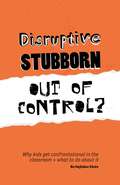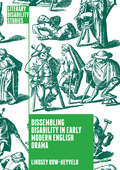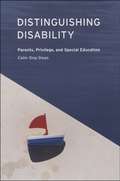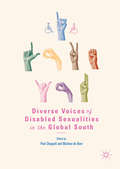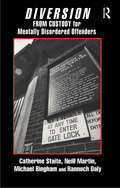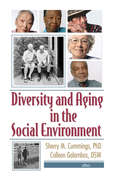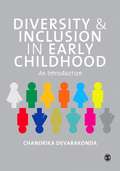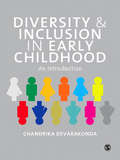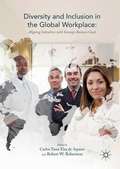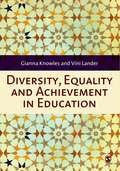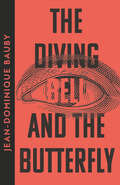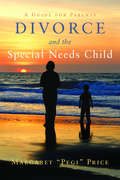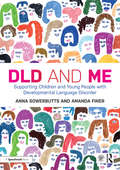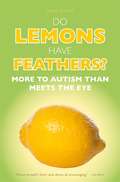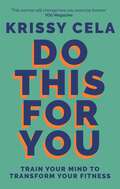- Table View
- List View
Disruptive, Stubborn, Out of Control?: Why kids get confrontational in the classroom, and what to do about it
by Bo Hejlskov ElvénOne of the biggest challenges in the classroom is trying to teach when students act in unexpected and annoying ways. Based on the psychology of how children and people act, this book offers practical strategies for understanding why your students are behaving in the way they are, and how to react in a way that restores peace and harmony in the classroom. With many examples of typical confrontational behaviours and clues for how to understand and resolve the underlying issues, this book will be every stressed teacher's best friend.
Disruptive, Stubborn, Out of Control?: Why kids get confrontational in the classroom, and what to do about it (PDF)
by Bo Hejlskov ElvénOne of the biggest challenges in the classroom is trying to teach when students act in unexpected and annoying ways. Based on the psychology of how children and people act, this book offers practical strategies for understanding why your students are behaving in the way they are, and how to react in a way that restores peace and harmony in the classroom. With many examples of typical confrontational behaviours and clues for how to understand and resolve the underlying issues, this book will be every stressed teacher's best friend.
Dissembling Disability in Early Modern English Drama (Literary Disability Studies)
by Lindsey Row-HeyveldWhy do able-bodied characters fake disability in 40 early modern English plays? This book uncovers a previously unexamined theatrical tradition and explores the way counterfeit disability captivated the Renaissance stage. Through detailed case studies of both lesser-known and canonical plays (by Shakespeare, Jonson, Marston, and others), Lindsey Row-Heyveld demonstrates why counterfeit disability proved so useful to early modern playwrights. Changing approaches to almsgiving in the English Reformation led to increasing concerns about feigned disability. The theater capitalized on those concerns, using the counterfeit-disability tradition to explore issues of charity, epistemology, and spectatorship. By illuminating this neglected tradition, this book fills an important gap in both disability history and literary studies, and explores how fears of counterfeit disability created a feedback loop of performance and suspicion. The result is the still-pervasive insistence that even genuinely disabled people must perform in order to, paradoxically, prove the authenticity of their impairments.
Distinguishing Disability: Parents, Privilege, and Special Education
by Colin Ong-DeanStudents in special education programs can have widely divergent experiences. For some, special education amounts to a dumping ground where schools unload their problem students, while for others, it provides access to services and accommodations that drastically improve chances of succeeding in school and beyond. Distinguishing Disability argues that this inequity in treatment is directly linked to the disparity in resources possessed by the students’ parents. Since the mid-1970s, federal law has empowered parents of public school children to intervene in virtually every aspect of the decision making involved in special education. However, Colin Ong-Dean reveals that this power is generally available only to those parents with the money, educational background, and confidence needed to make effective claims about their children’s disabilities and related needs. Ong-Dean documents this class divide by examining a wealth of evidence, including historic rates of learning disability diagnosis, court decisions, and advice literature for parents of disabled children. In an era of expanding special education enrollment, Distinguishing Disability is a timely analysis of the way this expansion has created new kinds of inequality.
Distinguishing Disability: Parents, Privilege, and Special Education
by Colin Ong-DeanStudents in special education programs can have widely divergent experiences. For some, special education amounts to a dumping ground where schools unload their problem students, while for others, it provides access to services and accommodations that drastically improve chances of succeeding in school and beyond. Distinguishing Disability argues that this inequity in treatment is directly linked to the disparity in resources possessed by the students’ parents. Since the mid-1970s, federal law has empowered parents of public school children to intervene in virtually every aspect of the decision making involved in special education. However, Colin Ong-Dean reveals that this power is generally available only to those parents with the money, educational background, and confidence needed to make effective claims about their children’s disabilities and related needs. Ong-Dean documents this class divide by examining a wealth of evidence, including historic rates of learning disability diagnosis, court decisions, and advice literature for parents of disabled children. In an era of expanding special education enrollment, Distinguishing Disability is a timely analysis of the way this expansion has created new kinds of inequality.
Distinguishing Disability: Parents, Privilege, and Special Education
by Colin Ong-DeanStudents in special education programs can have widely divergent experiences. For some, special education amounts to a dumping ground where schools unload their problem students, while for others, it provides access to services and accommodations that drastically improve chances of succeeding in school and beyond. Distinguishing Disability argues that this inequity in treatment is directly linked to the disparity in resources possessed by the students’ parents. Since the mid-1970s, federal law has empowered parents of public school children to intervene in virtually every aspect of the decision making involved in special education. However, Colin Ong-Dean reveals that this power is generally available only to those parents with the money, educational background, and confidence needed to make effective claims about their children’s disabilities and related needs. Ong-Dean documents this class divide by examining a wealth of evidence, including historic rates of learning disability diagnosis, court decisions, and advice literature for parents of disabled children. In an era of expanding special education enrollment, Distinguishing Disability is a timely analysis of the way this expansion has created new kinds of inequality.
Distinguishing Disability: Parents, Privilege, and Special Education
by Colin Ong-DeanStudents in special education programs can have widely divergent experiences. For some, special education amounts to a dumping ground where schools unload their problem students, while for others, it provides access to services and accommodations that drastically improve chances of succeeding in school and beyond. Distinguishing Disability argues that this inequity in treatment is directly linked to the disparity in resources possessed by the students’ parents. Since the mid-1970s, federal law has empowered parents of public school children to intervene in virtually every aspect of the decision making involved in special education. However, Colin Ong-Dean reveals that this power is generally available only to those parents with the money, educational background, and confidence needed to make effective claims about their children’s disabilities and related needs. Ong-Dean documents this class divide by examining a wealth of evidence, including historic rates of learning disability diagnosis, court decisions, and advice literature for parents of disabled children. In an era of expanding special education enrollment, Distinguishing Disability is a timely analysis of the way this expansion has created new kinds of inequality.
Distinguishing Disability: Parents, Privilege, and Special Education
by Colin Ong-DeanStudents in special education programs can have widely divergent experiences. For some, special education amounts to a dumping ground where schools unload their problem students, while for others, it provides access to services and accommodations that drastically improve chances of succeeding in school and beyond. Distinguishing Disability argues that this inequity in treatment is directly linked to the disparity in resources possessed by the students’ parents. Since the mid-1970s, federal law has empowered parents of public school children to intervene in virtually every aspect of the decision making involved in special education. However, Colin Ong-Dean reveals that this power is generally available only to those parents with the money, educational background, and confidence needed to make effective claims about their children’s disabilities and related needs. Ong-Dean documents this class divide by examining a wealth of evidence, including historic rates of learning disability diagnosis, court decisions, and advice literature for parents of disabled children. In an era of expanding special education enrollment, Distinguishing Disability is a timely analysis of the way this expansion has created new kinds of inequality.
Distinguishing Disability: Parents, Privilege, and Special Education
by Colin Ong-DeanStudents in special education programs can have widely divergent experiences. For some, special education amounts to a dumping ground where schools unload their problem students, while for others, it provides access to services and accommodations that drastically improve chances of succeeding in school and beyond. Distinguishing Disability argues that this inequity in treatment is directly linked to the disparity in resources possessed by the students’ parents. Since the mid-1970s, federal law has empowered parents of public school children to intervene in virtually every aspect of the decision making involved in special education. However, Colin Ong-Dean reveals that this power is generally available only to those parents with the money, educational background, and confidence needed to make effective claims about their children’s disabilities and related needs. Ong-Dean documents this class divide by examining a wealth of evidence, including historic rates of learning disability diagnosis, court decisions, and advice literature for parents of disabled children. In an era of expanding special education enrollment, Distinguishing Disability is a timely analysis of the way this expansion has created new kinds of inequality.
Diverse Voices of Disabled Sexualities in the Global South
by Paul Chappell Marlene De BeerThis volume aims to critically engage with constructs and experiences of disabled sexualities through Africa, Asia, Latin America and the Caribbean. In doing so, it is hoped that the questions raised, relfections, analyses and arguments will provide readers with a catalyst through which to (re)think disabled sexualities from the perspective of the Global South. What makes this edited volume unique is besides chapters from emerging academics and disability activists who either live or work in the Global South, it also includes personal contributions from disabled people across the Global South. This volume takes a broad perspective on disabled sexualities addressing such areas as gender, race, culture, colonialism, body image, sexual pleasure, sexuality education, sexual access, sexual and reproductive health services, queer sexualities, and sexual rights and justice. The volume will be of interest to international and national organisations for people with disabilities, gender and sexuality researchers, health professionals, social workers, academics and students at all higher education and training institutions interested in disability, gender queer and sexuality studies.
Diversion from Custody for Mentally Disordered Offenders
by Catherine Staite Neill Martin Rannoch DalyThe authors aim to provide practical guidance to enable practitioners in the various criminal justice, health and social care agencies to divert mentally disordered offenders from prosecution and custody and to help prevent re-offending.
Diversion from Custody for Mentally Disordered Offenders
by Catherine Staite Neill Martin Rannoch DalyThe authors aim to provide practical guidance to enable practitioners in the various criminal justice, health and social care agencies to divert mentally disordered offenders from prosecution and custody and to help prevent re-offending.
Diversity and Aging in the Social Environment
by Sherry M. Cummings Colleen GalambosToday, nearly one of every eight Americans is 65 or older, and by 2030, over 20% of the population will be in this age group. Are you prepared to work with this vastly diverse-and rapidly growing-population?This single source is designed to help social service professionals provide effective services to America&’s vastly diverse and rapidly growing elderly population. Diversity and Aging in the Social Environment explores the impact of race/ethnicity, gender, sexual orientation, and geographic location on elders&’ strengths, challenges, needs, and resources to provide you with a more complete understanding of the issues elders face. In order to be more responsive to older adults, social workers and other human service professionals need to enhance their knowledge of the aging population and the factors that impact the way seniors interact with society, organizations, community resources, neighborhoods, support networks, kinship groups, family, and friends. Diversity and Aging in the Social Environment examines differences in race, ethnicity, geographical location, sexual orientation, religion, and health status to help current and future human service professionals provide culturally competent services to the diverse range of elderly people they serve. In addition, it addresses the wide disparity that exists for older Americans in terms of income and assets, number of chronic conditions, functional and cognitive impairment, housing arrangements, and access to health care. This book provides a context for the examination of diversity issues among older adults by describing and discussing several theoretical perspectives on aging that highlight important aspects of diversity. Next, you&’ll find thoughtful examinations of: issues and challenges faced by lesbian, gay, bisexual, and transgender elders-and the strengths they bring into later life the impact of gender, race, and sexual orientation on prevalence rates, risk factors, methods of disease contraction, and mortality rates among older adults with HIV/AIDS-along with a discussion of the psychosocial issues they face diverse characteristics of custodial grandparents-and the influence of the caregivers&’ gender, race, age, and geographic location on methods of care and available caregiver support differences in caregiver characteristics, service utilization, caregiver strain, and coping mechanisms among several racial/ethnic groups of adults who care for elderly, disabled, and ill persons cultural/religious factors that influence interactions between health care personnel and Japanese-American elders the relationship between acculturation and depressive symptoms among Mexican-American couples life challenges facing Jewish and African-American elders-with a look at each group&’s coping mechanisms differences in religious/spiritual coping skills among Native American, African-American, and white elders psychological well-being and religiosity among a diverse group of rural elders
Diversity and Aging in the Social Environment
by Sherry M. Cummings Colleen GalambosToday, nearly one of every eight Americans is 65 or older, and by 2030, over 20% of the population will be in this age group. Are you prepared to work with this vastly diverse-and rapidly growing-population?This single source is designed to help social service professionals provide effective services to America&’s vastly diverse and rapidly growing elderly population. Diversity and Aging in the Social Environment explores the impact of race/ethnicity, gender, sexual orientation, and geographic location on elders&’ strengths, challenges, needs, and resources to provide you with a more complete understanding of the issues elders face. In order to be more responsive to older adults, social workers and other human service professionals need to enhance their knowledge of the aging population and the factors that impact the way seniors interact with society, organizations, community resources, neighborhoods, support networks, kinship groups, family, and friends. Diversity and Aging in the Social Environment examines differences in race, ethnicity, geographical location, sexual orientation, religion, and health status to help current and future human service professionals provide culturally competent services to the diverse range of elderly people they serve. In addition, it addresses the wide disparity that exists for older Americans in terms of income and assets, number of chronic conditions, functional and cognitive impairment, housing arrangements, and access to health care. This book provides a context for the examination of diversity issues among older adults by describing and discussing several theoretical perspectives on aging that highlight important aspects of diversity. Next, you&’ll find thoughtful examinations of: issues and challenges faced by lesbian, gay, bisexual, and transgender elders-and the strengths they bring into later life the impact of gender, race, and sexual orientation on prevalence rates, risk factors, methods of disease contraction, and mortality rates among older adults with HIV/AIDS-along with a discussion of the psychosocial issues they face diverse characteristics of custodial grandparents-and the influence of the caregivers&’ gender, race, age, and geographic location on methods of care and available caregiver support differences in caregiver characteristics, service utilization, caregiver strain, and coping mechanisms among several racial/ethnic groups of adults who care for elderly, disabled, and ill persons cultural/religious factors that influence interactions between health care personnel and Japanese-American elders the relationship between acculturation and depressive symptoms among Mexican-American couples life challenges facing Jewish and African-American elders-with a look at each group&’s coping mechanisms differences in religious/spiritual coping skills among Native American, African-American, and white elders psychological well-being and religiosity among a diverse group of rural elders
Diversity and Inclusion in Early Childhood: An Introduction (PDF)
by Chandrika DevarakondaCovering a wide range of concepts and taking a broader perspective of what inclusion entail, this book offers an overview of current research, policy and practice in diversity and inclusion in the early years. It is a clear introduction to what inclusive practice means for those working with young children in the early stages of their lives. With case studies and activities designed to help students relate to diverse situations, the author discusses the main issues surrounding: - race - gender - culture - disability and Special Educational Needs - English as an Additional Language - Traveller children - the contexts of inclusion and exclusion - good practice in early childhood settings - different perspectives of inclusion This is essential reading for students studying inclusion and diversity on early childhood or early years courses, and those seeking to promote good practice and enable all children to develop to their full potential irrespective of their background. 'The success of this book is in its ability to explore inclusion from a wide perspective. Offering a range of thought-provoking material, such as reflective questions, debates and controversies, practitioner, parent and children's views, legislation, activities, and examples of good practice, will keep readers interested and actively engaged throughout the book'-Dr Anna Kilderry, Senior Lecturer, Early Childhood Education, Victoria University, Melbourne, Australia Chandrika Devarakonda is a Senior Lecturer in the Faculty of Education and Children's Services at the University of Chester.
Diversity and Inclusion in Early Childhood: An Introduction
by Chandrika DevarakondaCovering a wide range of concepts and taking a broader perspective of what inclusion entail, this book offers an overview of current research, policy and practice in diversity and inclusion in the early years. It is a clear introduction to what inclusive practice means for those working with young children in the early stages of their lives. With case studies and activities designed to help students relate to diverse situations, the author discusses the main issues surrounding: - race - gender - culture - disability and Special Educational Needs - English as an Additional Language - Traveller children - the contexts of inclusion and exclusion - good practice in early childhood settings - different perspectives of inclusion This is essential reading for students studying inclusion and diversity on early childhood or early years courses, and those seeking to promote good practice and enable all children to develop to their full potential irrespective of their background. 'The success of this book is in its ability to explore inclusion from a wide perspective. Offering a range of thought-provoking material, such as reflective questions, debates and controversies, practitioner, parent and children's views, legislation, activities, and examples of good practice, will keep readers interested and actively engaged throughout the book'-Dr Anna Kilderry, Senior Lecturer, Early Childhood Education, Victoria University, Melbourne, Australia Chandrika Devarakonda is a Senior Lecturer in the Faculty of Education and Children's Services at the University of Chester.
Diversity and Inclusion in the Global Workplace: Aligning Initiatives with Strategic Business Goals
by Carlos Tasso Aquino Robert W. RobertsonThis edited collection offers a nontraditional approach to diversity management, going beyond gender, race, and ethnicity. Examining ageism, disability, and spirituality, the book provides a discussion of different D&I applications and introduces a framework consisting of a diagnostic phase, gap analysis, and an action plan, which can be modified to attend to specific needs of organizations. Researchers and practitioners will learn a viable way to address diversity in global organizations.
Diversity, Equality and Achievement in Education
by Gianna Knowles Vini LanderMost classrooms contain children from a variety of backgrounds, where home culture, religious beliefs and the family's economic situation all impact on achievement. This needs to be recognised by teachers in order to establish fair, respectful, trusting and constructive relationships with children and their families, which will allow every child to reach their full potential. This book looks at real issues that affect teachers in the classroom, and examines a variety of influences affecting child development. It provides you with the theoretical and practical information you need to ensure you understand the complex factors which affect the children in your care, and it encourages good, thoughtful teaching. Dealing with some of the less widely addressed aspects of diversity and inclusion, the book considers: - children who are asylum seekers - the notion of 'pupil voice' - what diversity and equality mean in practice - gender and achievement - looked-after children - social class - disability - ethnicity and whiteness This book is essential reading for any education student looking at diversity and inclusion, and for teachers in role looking for advice on how to meet the professional standards.
The Diving-Bell and the Butterfly: A Memoir Of Life In Death (4th Estate Matchbook Classics Ser.)
by Jean-Dominique Bauby‘Locked-in syndrome: paralysed from head to toe, the patient, his mind intact, is imprisoned inside his own body, unable to speak or move. In my case, blinking my left eyelid is my only means of communication.’
Divorce and the Special Needs Child: A Guide for Parents
by Margaret Pegi PriceGoing through a divorce is always tough, but when a child with special needs is involved it can be especially challenging. This book takes a clear and comprehensive look at every aspect of the legal divorce process, and addresses all of the legal issues that divorcing parents of children with special needs face. The author guides parents through the initial hurdles of choosing the right lawyer for their case, and explains exactly how to work with them to achieve the best possible outcome for all concerned. From agreeing upon child custody arrangements that meet the particular needs of the child, to making provision for child support payments, gathering together the documentation needed to prove a case, and dealing with financial issues such as debts and property distribution, no aspect of divorce is left uncovered. A set of checklists is included to ensure that parents consider everything they need to, and the book concludes with a useful list of further resources. Written by an experienced family lawyer who went through her own divorce when her son, who has autism, was six, this book offers much-needed guidance to divorcing parents of children with a variety of special needs.
Divorce and the Special Needs Child: A Guide for Parents (PDF)
by Margaret Pegi PriceGoing through a divorce is always tough, but when a child with special needs is involved it can be especially challenging. This book takes a clear and comprehensive look at every aspect of the legal divorce process, and addresses all of the legal issues that divorcing parents of children with special needs face. The author guides parents through the initial hurdles of choosing the right lawyer for their case, and explains exactly how to work with them to achieve the best possible outcome for all concerned. From agreeing upon child custody arrangements that meet the particular needs of the child, to making provision for child support payments, gathering together the documentation needed to prove a case, and dealing with financial issues such as debts and property distribution, no aspect of divorce is left uncovered. A set of checklists is included to ensure that parents consider everything they need to, and the book concludes with a useful list of further resources. Written by an experienced family lawyer who went through her own divorce when her son, who has autism, was six, this book offers much-needed guidance to divorcing parents of children with a variety of special needs.
DLD and Me: Supporting Children and Young People with Developmental Language Disorder
by Anna Sowerbutts Amanda FinerDespite an increasing awareness of Developmental Language Disorder, there are very few tools available to help people understand and live with a diagnosis of DLD. DLD and Me is a functional, engaging resource for children and young people with DLD and the professionals and families that work with them. The book consists of an easy-to-follow, 12-week programme designed to help children and young people understand their strengths, what makes them different, what DLD is and how they can support their own communication in everyday life. Key features include: clearly worded session plans for therapists or education staff to follow; engaging visual resources to accompany the session plans, each available to photocopy and download; home sheets to keep families involved and informed; information sheets and training plans for parents and education staff; outcome measures to evaluate progress. This invaluable tool has been designed to be used by Speech and Language Therapists, teachers and other professionals or parents working with children and young people with DLD.
Do Lemons Have Feathers?: More to Autism than Meets the Eye
by Andrew Sercombe David J. Burns"Are you beginning to see past the disability and starting to appreciate the gift?" In this unashamedly honest book, David J. Burns draws on his own lived experience of Autism Spectrum Disorder (ASD) to provide guidance on how to take advantage of the supposed disadvantage. The book is filled with often hilarious anecdotes, spanning the confusion of his early diagnosis, to his marriage and life with his four children, as David proffers his advice on how to cope with everything from school work to flirting. Part memoir, part guide, and written with a refreshingly funny outlook, this book can be picked up and dipped into whether you're looking for encouragement, practical coping strategies, or a perspective of life as seen through the lens of ASD.
Do Lemons Have Feathers?: More to Autism than Meets the Eye (PDF)
by Andrew Sercombe David J. Burns"Are you beginning to see past the disability and starting to appreciate the gift?" In this unashamedly honest book, David J. Burns draws on his own lived experience of Autism Spectrum Disorder (ASD) to provide guidance on how to take advantage of the supposed disadvantage. The book is filled with often hilarious anecdotes, spanning the confusion of his early diagnosis, to his marriage and life with his four children, as David proffers his advice on how to cope with everything from school work to flirting. Part memoir, part guide, and written with a refreshingly funny outlook, this book can be picked up and dipped into whether you're looking for encouragement, practical coping strategies, or a perspective of life as seen through the lens of ASD.
Do This for You: Train Your Mind To Transform Your Fitness
by Krissy Cela'This woman will change how you exercise forever' - YOU MAGAZINE Instagram sensation Krissy Cela is the one-woman revolution set to transform how you think about fitness.It's time to reassess your approach to getting fit! No more crazy self-punishment, 'miracle' diets or one-size-fits-all rules. Having changed the lives of millions of people through her no-nonsense, friendly and supportive coaching, Krissy Cela wants to show you that being healthy in body happens most effectively when you focus on the right mindset.Krissy will shift your thinking away from how you want to look to how you want to feel. Feeling confident and happy will always be more important than your dress size.Krissy will give you the tools to deal with mental barriers such as anxiety, stress and low self-esteem, which affect more of us than ever before. She will help you challenge negative thinking to help you build healthy habits that deliver long-lasting, realistic results. A balanced lifestyle will become as second nature to you as brushing your teeth, and you won't have to give up the food you love!Do This for You gives you everything you need to feel good in body and mind, every single day. Chapters include:1. Find Your 'Why'2. Lose the Excuses3. Maximise Your Time4. Form Healthy Habits5. Shift Your Perspective6. Believe You Can7. Find Your Tribe8. Embrace the Fear9. Be More Than Motivated10. Build Your Strength11. Love Your Food12. Do This for You
